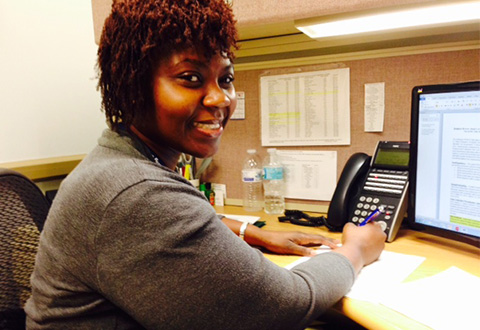Focus on Falls Prevention

NCPS Patient Safety Fellow Chanedra Mells, M.P.H.
Falls are a major concern at health care facilities nationwide, which is why Chanedra Mells, M.P.H., has focused her patient safety fellowship on fall prevention at the James A. Haley Veterans’ Hospital, Tampa, Fla.
“After studying literature related to a Breakthrough Series on fall and injury prevention, I learned that fall prevention in hospice and palliative care was identified as an area of significant concern,” she said. “In light of this, I decided to survey the current status of our efforts in these areas.”
She learned that previous fiscal years’ fall rates at the facility hospice and palliative care unit were higher than other VISN 8 hospice and palliative care units.
“It turns out that traditional evidence-based fall prevention interventions are not as effective when used with hospice and palliative care patients,” Mells said. “Fall prevention strategies need to be modified for these patients."
Conventional fall reduction methods, such as adding strengthening exercises and reducing medications, were not being used because they often did not align with providing comfort and maintaining the best possible quality of life for patients, which are traditional hospice goals.
“Our facility’s fall prevention policy is focused on the use of screening and fall risk assessments,” she noted, “which we use to select the most appropriate evidence-based interventions.”
Current facility fall prevention interventions include:
- Bed or chair alarms
- Frequent monitoring
- Close observation
- Low beds
- Personal items kept within close reach
- One-to-one **
“Although the nursing staff selects interventions based on a patient’s fall risk screening and assessment, falls still occur in the unit because a patient’s physical and mental status sometimes changes from day-to-day, increasing their fall risk,” said Mells.
Though she has not yet completed her efforts, she has begun to focus on efforts that could reduce the fall rate.
"Firstly, try to identify the root cause of why patients are falling,” Mells said. “Is there a pattern that can be found among patients who fall? Is it restlessness? Need to sit up? Go to bathroom?”
She also recommends reviewing current literature to determine the effectiveness of fall prevention equipment, such as bed alarms.
“We can’t prevent all falls,” Mells said. “Many of our Veterans want to be independent and may get up without asking for help, which can lead to a fall.”
“Therefore our goal at the VA has continued to be injury prevention. So if someone does fall in our care, we want to prevent them from being injured,” she concluded. “I’m glad that my fellowship is focused on contributing to this effort.”
** When nurses and/or nurse assistants sit with a patient around the clock; used for patients with a very high risk of falling
Learn More
All links below retrieved May 21, 2015.
-
NCPS offers wide range of fall prevention strategies in the Falls Toolkit
-
The Joint Commission Sentinel Event Statistics. Event Type by Year 2002-2014.
-
Boyle, D. (2012). Falls in Older Adults with Cancer: A Call to Action Cancer Network.
-
Kline, N. E., Davis, M.E., & Thom, B. Fall Risk Assessment and Prevention Cancer Network.
-
Capezuti, E. et al (2008) Bed-Exit Alarm Effectiveness. Archives of Gerontology and Geriatrics.
-
Currie, L. (2008). Fall and injury prevention. An evidence based handbook for nurses. AHRQ.
-
Gray, J. (2007). Protecting Hospice Patients: A New Look at Falls Prevention. American Journal of Hospice and Palliative Medicine.
-
Goodridge, D., & Marr, H. (2002). Factors Associated with falls in an inpatient palliative care unit: an exploratory study. International Journal of Palliative Nursing.



















